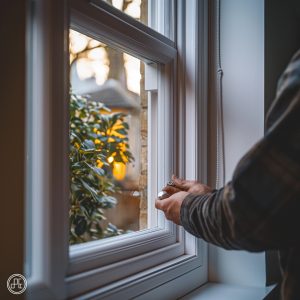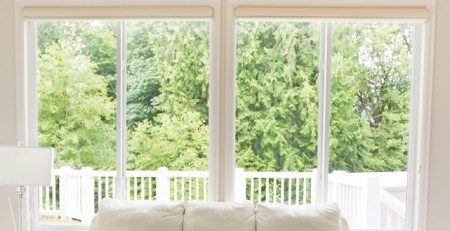Essential Sash Window Maintenance Checklist: Keep Your Windows Gleaming
Sash windows, emblematic of historical and aesthetic value, are as functional as beautiful. Ensuring their upkeep is about maintaining their appearance, preserving their structural integrity, and maximising their operational efficiency. Maintenance of these windows is critical, particularly given their exposure to environmental elements and mechanical components’ natural wear and tear.
Here’s a detailed guide on how to keep these classic fixtures in prime condition.
Seasonal Timing for Maintenance
The optimal time for conducting a thorough check and maintenance routine on sash windows is during the spring. This timing is strategic; it follows the harsh conditions of winter, which can significantly stress the structural and surface integrity of the windows. The cold can cause the materials to contract and expand, leading to vulnerabilities such as cracks or warped wood. A springtime maintenance schedule allows for timely identification and repair of any damage incurred, ensuring the windows are in good shape to face the more temperate months ahead.
Frequency of Inspections
 The frequency of inspections should vary based on the age and condition of the windows. A biannual inspection is advisable for newer installations, ideally once every 5-8 years. However, more frequent inspections are necessary for older or historically significant windows due to age-related susceptibilities such as wood decay, outdated sealing materials, and the general deterioration of mechanical parts like cords and pulleys.
The frequency of inspections should vary based on the age and condition of the windows. A biannual inspection is advisable for newer installations, ideally once every 5-8 years. However, more frequent inspections are necessary for older or historically significant windows due to age-related susceptibilities such as wood decay, outdated sealing materials, and the general deterioration of mechanical parts like cords and pulleys.
Visual Inspection Protocols
A comprehensive visual inspection is the first step in the maintenance routine. This involves examining the window box and frame for any signs of cracks, gaps, or other forms of deterioration. It’s crucial to ensure no rotting wood or rusting metal components, as these can jeopardise the window’s structural integrity. Also, checking for loose or cracked glazing and ensuring that the putty or sealants holding the glass are intact is vital. Any damage, no matter how minor it seems, can escalate if not addressed promptly.
Surface Maintenance Techniques
Maintaining the surface of sash windows primarily involves dealing with the paintwork. It’s advisable to strip and repaint the windows as necessary to avoid the buildup of excessive paint layers, which can impair the sash’s operation by adding undue weight and friction. Regular maintenance should also include using sash brushes for a smooth application, ensuring that the paint does not interfere with the window’s movement.
Functional Checks
Ensuring the windows operate smoothly involves checking the seals, cords, latches, and handles. It’s essential to identify any sticking points or operational hindrances. Any faulty elements should be replaced immediately to prevent further damage and to maintain ease of use. Sticking or jamming can be frustrating and lead to more significant damage if the window is forced.
Minor Repairs and Lubrication
 Regular cleaning of the windows with mild detergent helps maintain their appearance and functionality. Filling them promptly to prevent moisture ingress is critical for minor cracks or openings. Lubrication plays a vital role in the smooth operation of sash windows. Natural lubricants such as beeswax or candle wax on the tracks can facilitate smoother sliding. Additionally, hinges and pulleys should be lubricated periodically to ensure seamless movement.
Regular cleaning of the windows with mild detergent helps maintain their appearance and functionality. Filling them promptly to prevent moisture ingress is critical for minor cracks or openings. Lubrication plays a vital role in the smooth operation of sash windows. Natural lubricants such as beeswax or candle wax on the tracks can facilitate smoother sliding. Additionally, hinges and pulleys should be lubricated periodically to ensure seamless movement.
Damage Management and Mitigation
Immediate attention to broken parts like glass or cords is imperative. Replacing these components promptly restores functionality and prevents the issues from escalating into more severe problems. Additionally, keeping the tracks clear of debris and conducting spot repairs as soon as damage occurs can significantly extend the lifespan of the windows.
“Prompt damage management is crucial for sash windows. Addressing issues like cracked glass or fraying cords immediately prevents minor problems from escalating into major repairs. Quick action not only preserves the window’s functionality and aesthetic but also protects the building from further environmental damage. Always prioritise swift repairs to maintain the integrity and longevity of these classic structures.” – Arthur East, Sash Windows London.
Timber and Insulation Care
Managing moisture is crucial in preserving the timber components of sash windows. Regular checks for signs of wood decay or moisture ingress are necessary. Resealing or replacing timber showing deterioration can prevent more extensive damage. Updating sealants and using weather stripping are effective ways to enhance the insulation properties of the windows, thereby improving energy efficiency and reducing heat loss.
Aesthetic and Safety Upkeep
Regular cleaning of the windows using microfiber cloths can prevent scratches and ensure the glass remains clear and streak-free. After cleaning, applying a fresh layer of paint can help protect the wood and maintain the window’s aesthetic appeal. It’s also essential to ensure that all safety features, such as enhanced locks and child restrictors, are functional and in place.
Professional Support and Documentation
 When it comes to maintaining sash windows, particularly those that are older or of historical significance, the involvement of professionals cannot be overstated. Specialist contractors who have experience with sash windows are indispensable for addressing complex structural issues that might be beyond the scope of routine maintenance. These experts can provide services ranging from precision repairs to complete refurbishments, ensuring that all interventions are sympathetic to the original design and materials of the windows.
When it comes to maintaining sash windows, particularly those that are older or of historical significance, the involvement of professionals cannot be overstated. Specialist contractors who have experience with sash windows are indispensable for addressing complex structural issues that might be beyond the scope of routine maintenance. These experts can provide services ranging from precision repairs to complete refurbishments, ensuring that all interventions are sympathetic to the original design and materials of the windows.
Professional help ensures the work is done to the highest standards and helps diagnose underlying issues that may not be immediately apparent to the untrained eye. For instance, an expert might identify the need for structural reinforcements or specialised treatments against wood rot or pest infestation, which can significantly extend the lifespan of the windows.
In addition to active interventions, maintaining thorough documentation of all maintenance and repairs performed is crucial. This documentation should include dates, details of the work, materials used, and information about the professionals involved. Such records are invaluable for several reasons:
- Historical Integrity: For heritage properties, detailed records support the preservation of the building’s historical accuracy and can be crucial during restoration projects.
- Resale Value: Comprehensive maintenance logs can enhance the property’s market value, providing potential buyers with assurance regarding the condition and upkeep of its features.
- Future Maintenance: Well-kept records help plan future maintenance cycles and guide repair decisions, ensuring consistency in the care and materials used.
Final Thoughts
In summary, maintaining sash windows is a multifaceted endeavour beyond simple aesthetics. It involves a detailed understanding of the windows’ materials, mechanics, and historical context, coupled with a strategic approach to their care.
By embracing both traditional techniques and modern advancements in window care, homeowners can ensure their sash windows remain a lasting and functional tribute to architectural history, enhancing the beauty and value of their homes for years to come.





